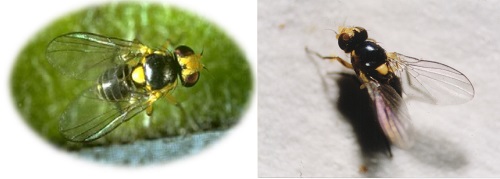Overwintering, cold tolerance and supercooling capacity comparison between Liriomyza sativae and L. trifolii, two invasive leafminers in China
Qikai Zhang, Shengyong Wu, Haihong Wang, Zhenlong Xing & Zhongren Lei

三叶斑潜蝇(左)和美洲斑潜蝇(右) 中国农科院供图

美洲斑潜蝇与三叶斑潜蝇在我国沿纬度梯度越冬能力的比较 中国农科院供图
近日,中国农业科学院植物保护研究所经济作物害虫研究创新团队研究发现,入侵我国的三叶斑潜蝇相较于先前入侵的美洲斑潜蝇有更强的越冬能力、低温存活能力和更低的过冷却点,结果表明三叶斑潜蝇在未来具有很大潜力在高纬度地区定殖。相关结果在线发表于《害虫科学》(Journal of Pest Science)。
美洲斑潜蝇和三叶斑潜蝇都起源于美洲大陆,随着各国的贸易交往而发展成为世界性害虫。美洲斑潜蝇在20世纪90年代入侵我国,很快遍布全国大部分地区。而三叶斑潜蝇在21世纪初入侵我国,目前主要分布在东南沿海地区。二者寄主广,食性杂,给我国蔬菜和园艺产业造成了巨大危害。
越冬能力和耐寒性在很大程度上决定了入侵物种的地理分布,低温适应性还可以通过时间和物候差异影响入侵物种和当地物种之间的竞争取代。为了预测三叶斑潜蝇在我国北方地区的定殖潜力,该团队在我国北纬30°~38°范围内分别在沿海和内陆各选择了8个试验地点,模拟斑潜蝇的自然越冬环境和越冬过程。连续多年在选择的试验地点进行了两种斑潜蝇的越冬存活试验,同时进行系统的室内试验,详细比较了两种斑潜蝇的低温耐受性、低温存活率、最低致死温度、过冷却点等耐寒能力。
研究表明,相较于美洲斑潜蝇,三叶斑潜蝇能在更高纬度地区越冬,其低温存活率高于美洲斑潜蝇,过冷却点也低于美洲斑潜蝇,具有较强的耐寒性。因此,三叶斑潜蝇在我国北方地区具有更强的定殖和扩散能力。该研究对预测三叶斑潜蝇的入侵范围和制定治理策略有重要参考价值。
该研究得到国家重点研发计划和现代农业产业技术体系等项目资助。
来源:中国科学报 李晨 欧阳灿彬
Abstract
Liriomyza sativae Blanchard and Liriomyza trifolii (Burgess) are two highly polyphagous pests that successively invaded China in the 1990s and 2000s, respectively, threatening vegetable and horticultural plants. Competitive displacement of L. sativae by L. trifolii occurred during the expansion process of the latter in southern China, while whether L. trifolii can expand their range to northern China remains unclear. Overwintering and cold tolerance capacity largely determine the species distribution range and can affect species displacement through overwintering and phenology. In this study, we compared the overwintering potential, cold tolerance and supercooling point (SCP) between these two leafminer species. Our results showed that L. trifolii can overwinter at higher altitudes than L. sativae. In addition, we found that they can both successfully overwinter in greenhouses in northern China, and the overwintering capacity of L. trifolii was higher than that of L. sativae. Moreover, the extreme low-temperature survival of L. trifolii was significantly higher than that of L. sativae, and the SCP of the former was lower than that of the latter. We thus conclude that the overwintering and cold tolerance capacity of L. trifolii is much better than that of L. sativae. Our findings indicate that L. trifolii has the potential to displace L. sativae and expand its range to northern China. Moreover, our results have important implications for predicting overwinter ranges and developing management strategies for invasive leafminers in China.





 位访客
位访客